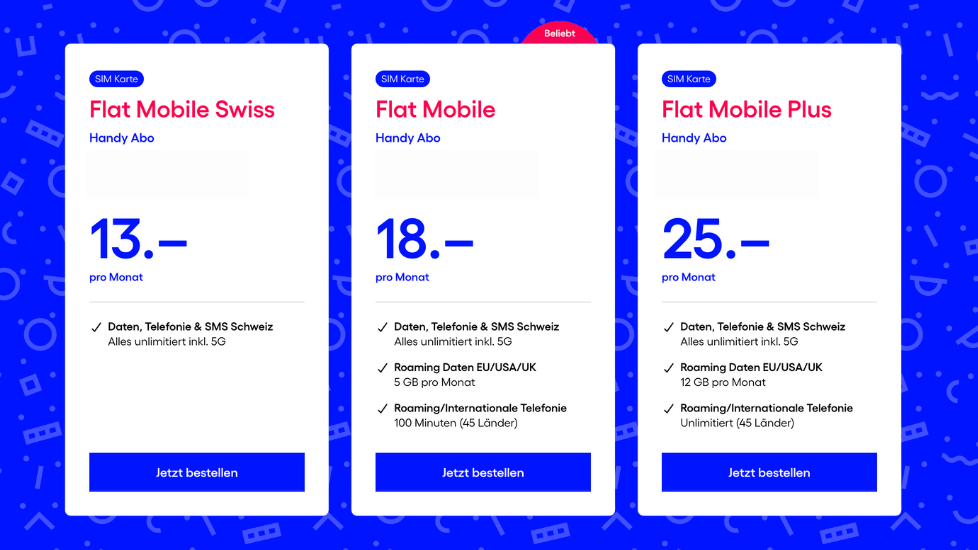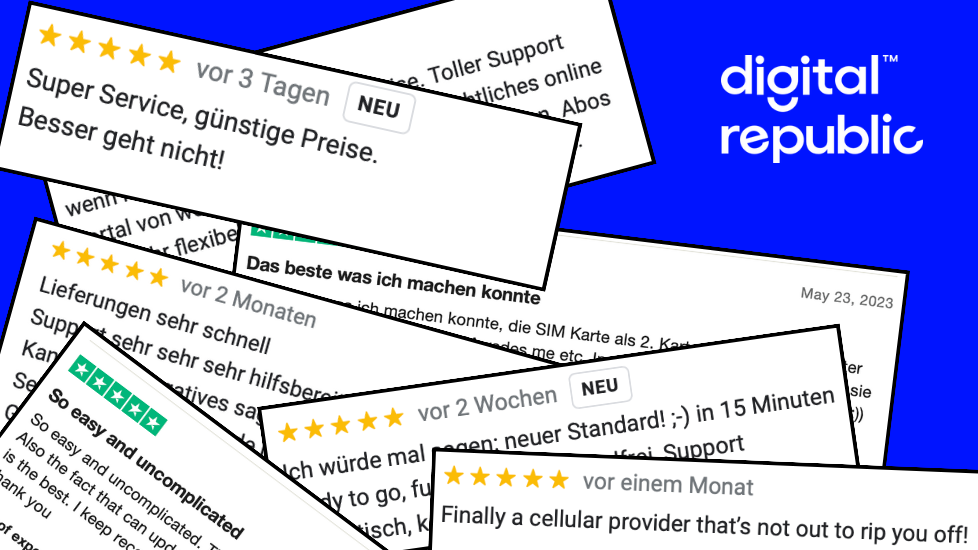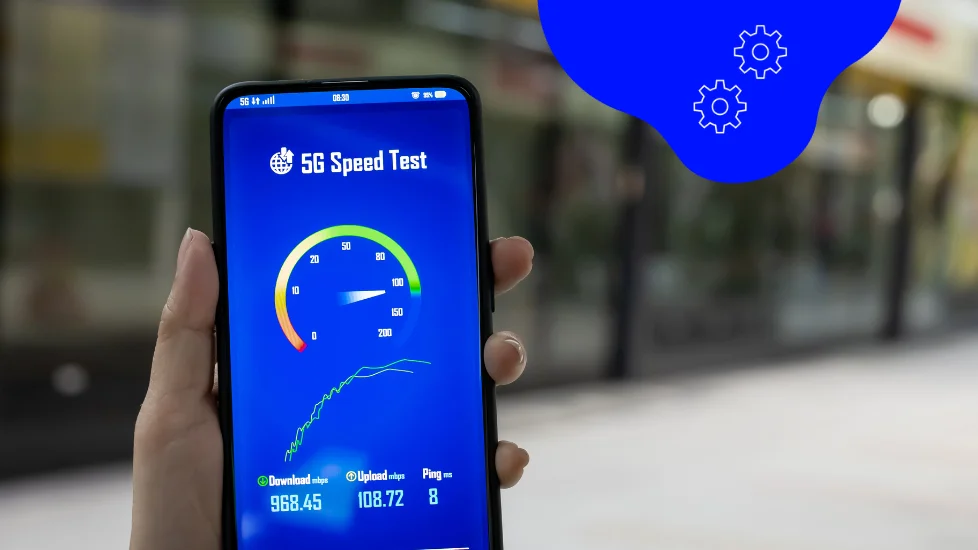Mobile internet for everyone and everything
The eSIM in Switzerland
Interview with Ralf Beyeler
The classic SIM card is being replaced more and more by the eSIM. As one of the first Swiss providers, we at Digital Republic have also opted for the eSIM and offer all our tariffs in this form as well. The renowned telecom expert Ralf Beyeler met with our Co-Founder Marco Arnold for an interview to talk about the potential of the eSIM. This much can be said: Not all providers know how to use the new technology, and the spread of the eSIM in Switzerland is still in its infancy. Nevertheless, the advantages for users are likely to have a lasting impact on the mobile communications market. All questions and answers can be found exclusively here.
The Interview
Marco Arnold: Do you use an eSIM in your current smartphone?
Ralf Beyeler: No, I don’t have an eSIM for one simple reason: I currently use an average smartphone with Android, and among Android phones, it’s mainly the newer and more expensive devices that support eSIM. My current device is already more than two years old and I don’t necessarily want to buy a new device every year for ecological reasons. So my device simply does not support eSIM yet.
MA: How many Swiss people currently have an eSIM?
RB: I don’t have exact figures on that, but you can take a look at the devices that support eSIM. Apple’s iPhones, for example, have supported eSIMs by default for several years. So you can at least say of iPhone users that they almost all have the ability to use eSIMs as well. The situation is completely different for Android devices: Most of the devices sold today do not support eSIMs. So, if you do not buy a high-end Android phone, you cannot expect an eSIM-capable device today.
MA: …and what about the use of the eSIM?
RB: If you look at the use of eSIM, you quickly realize that it is still a niche in Switzerland. On the one hand, this is due to the devices themselves, but on the other hand, there are still many providers in Switzerland who have a special approach to the topic of eSIM. For example, one of the three big Swiss providers still requires customers to go to a physical store to buy an eSIM. There, you then buy a cardboard card with the QR code for the eSIM printed on it. It’s a complete mystery to me how you can come up with such a process.
Ralf Beyeler, Telecom Expert Moneyland«It makes me wonder what the product managers were smoking when they developed these processes, that they are selling a completely digital product in physical stores rather over the internet.»
It would hardly occur to anyone to have an eTicket purchased online for the train printed out at the station counter and then collect it before boarding the train.
It almost seems as if certain providers deliberately want to put obstacles in the way of customers buying an eSIM. But as long as there are providers who sell their eSIMs in such a customer-unfriendly way as described above, the development of the eSIM in Switzerland will naturally be slowed down enormously, even among people who have a smartphone that would actually support eSIMs.
Ralf Beyeler, Telecom Expert Moneyland«But there are, of course, providers who act much more thoughtfully on the mobile market and offer digital solutions throughout. One of these providers is certainly Digital Republic.»
MA: Thank you for the compliment! What do you think is the reason why providers prevent the easy purchase of eSIMs in such a way?
RB: It’s difficult to say. One consideration could be that they can sell more roaming packages. Because a big advantage of eSIMs is that you can bypass traditional roaming. For example, when I go on vacation, I just quickly load a local eSIM onto my cell phone and thus don’t have to buy a roaming package from my Swiss network provider. The cost differences here can be immense.
In concrete terms: If I fly to Thailand, I get a volume of 16GB for 17 francs from a local provider. Compared to a roaming package from Switzerland, this saves hundreds of francs.
MA: Thailand is a great example. I’ve seen eSIM packages there with unlimited data volume for two weeks for $20. That’s a far cry from the usual Swiss roaming rates.
RB: Exactly!
MA: An eSIM is obviously enormously exciting for vacations. Do you see any other advantages that one enjoys with an eSIM?
RB: A clear advantage is certainly also the fact that as a customer I no longer have to wait for my SIM card. I have the opportunity to be connected much faster. Especially when it’s solved as elegantly as at Digital Republic, where I can simply order an eSIM online and the entire registration process, including ID verification, takes place online. I immediately get to my eSIM via QR code in the email and can get started.
And, what I myself always swear about: With certain cell phones, it’s super tedious to change the physical SIM card, it can jam, get stuck, the contacts can be defective, and so on. You no longer have that with the eSIM.
MA: So now the physical SIM card has evolved over the last thirty years, then got smaller and smaller, and is now probably going to disappear completely at some point. Do you think that will also lead to a certain revolution or at least upheaval in the mobile communications market?
RB: That’s difficult to assess. The SIM card – or now the eSIM – merely acts as a credential so that I can identify myself in my provider’s network and use its services. It is to be hoped that, despite the relatively strong structures with high market shares that prevail in Switzerland in a global comparison, independent providers such as Digital Republic will launch new products on the market to put some pressure on the big players. In Switzerland, we have unfortunately been in a situation for 2 decades in which the largest provider enjoys a market share of around 60% and this is hardly changing.
Ralf Beyeler, Telecom Expert Moneyland«The eSIM could also lead to customers perhaps being a little quicker to try out a different service and accordingly more likely to switch, as there is no need to go to a store and several SIM profiles can be used in parallel.»
This is where I see the biggest opportunity for the smaller providers with innovative products. In the end, however, it always depends on the offering, of course. The eSIM will simply be a small part of a new offering. So it is much more important that the new offering is convincing overall and also gives people an opportunity to test the product without obligation.
MA: These are very exciting inputs, and of course we are already working on some of them. We are trying to position ourselves in the market with non-binding testing and a free contract structure with easy switching.
Ralf Beyeler: Can I just interject here: The issue of “switching” is not the main focus for me with eSIM. It is always difficult to persuade a customer to switch. So you shouldn’t basically persuade customers of other providers to switch, but rather make your own offering attractive and then make it easy for them to try it out. When a customer hears the word “switch,” it is often immediately associated with hassle and effort. That is not goal-oriented. Digital Republic in particular has a clear unique selling proposition in that it offers free testing and all processes are digital. That speaks for itself, and there’s no need to bother potential customers with the word “switch”.
MA: You speak from my heart. With the eSIM, the SIM now becomes purely a software issue. You no longer have to insert a SIM card via an analog slot. Do you think the hardware manufacturers, such as Apple, could become gatekeepers for the providers here?
RB: Suggestions on the devices themselves, such as Apple might include, are rarely followed by consumers. Simply because the suggested providers are unknown to these people. The name is decisive for many customers, and they often won’t trust a provider they haven’t had the opportunity to get to know or who isn’t known to them from their environment. As a provider, you always have to build trust with the customer base first. Hardware manufacturers cannot simply bypass this.
MA: If we now look a little beyond the end of our nose in addition to the eSIM: What other technological developments do you see in the future of the mobile communications industry?
RB: I think things will primarily continue as before. 5G will continue to establish itself, then 6G will probably come at some point, then 7G. There will always be newer mobile communications standards. Frequencies will be used more efficiently to enable faster transmission rates for customers. I doubt that there will be a great and sudden revolution, but it will certainly happen step by step and old technologies will be replaced by newer ones. 30 years ago, I could record exactly one TV show with my VHS recorder and not watch any other recording during the recording. If you compare that to today, where I can stream more or less anything I want on demand with my cell phone, that’s a huge leap forward in a very short time. I don’t think anyone could have predicted that back then either, hence my reluctance to answer the question.
Marco Arnold: Brilliant, thank you very much for the interview.

If you are not yet a Digital Republic customer and want to benefit from the advantages of the eSIM, you can easily access all our tariffs as eSIM via our eSIM page. Existing customers can order an eSIM directly via their customer portal or convert their physical SIM to an eSIM.
Discover Our Other News Articles

The Development of Our Ideal Cell Phone Plans for Switzerland
The path to the current Trio Flat Mobile Swiss, Flat Mobile, and Flat Mobile Plus cell phone plans is also an example of how Digital Republic wants to function as a provider and where its priorities lie. We have quickly transformed ourselves from a pure data SIM provider to a cell phone plan provider. And we have completely rethought the development process.

The Affordable Mobile Provider With Award-Winning Service
When it comes to mobile providers in Switzerland, the wheat is often separated from the chaff when it comes to price. Either you pay little for your subscription and do without services like support or 5G, or you go to one of the big providers and pay more than you might like. At Digital Republic, you get both!

Why 5G Is Not Always Equally Fast
Sometimes fast, sometimes slow, sometimes suddenly 4G again. The network indicator on your smartphone suggests that it is connected to the internet via either 4G or 5G. In fact, a complex mechanism and a lot of communication between your smartphone and the network is taking place in the background to ensure that you always have the best possible connection.
